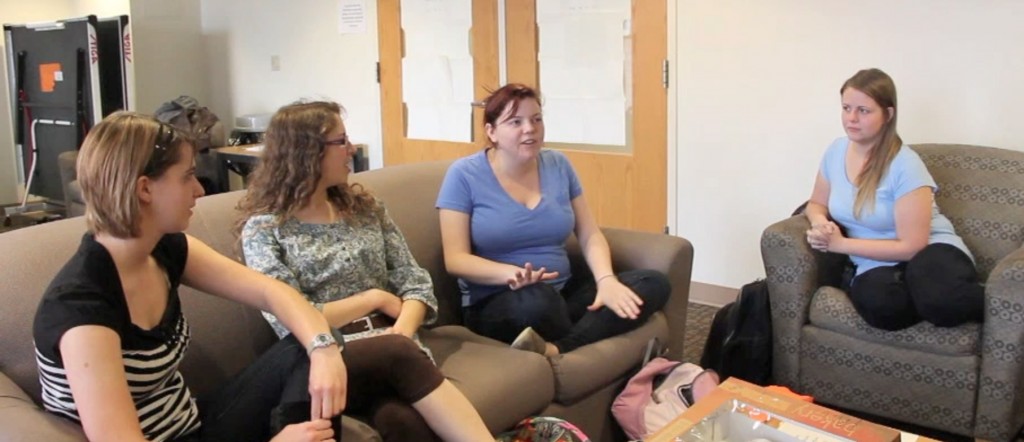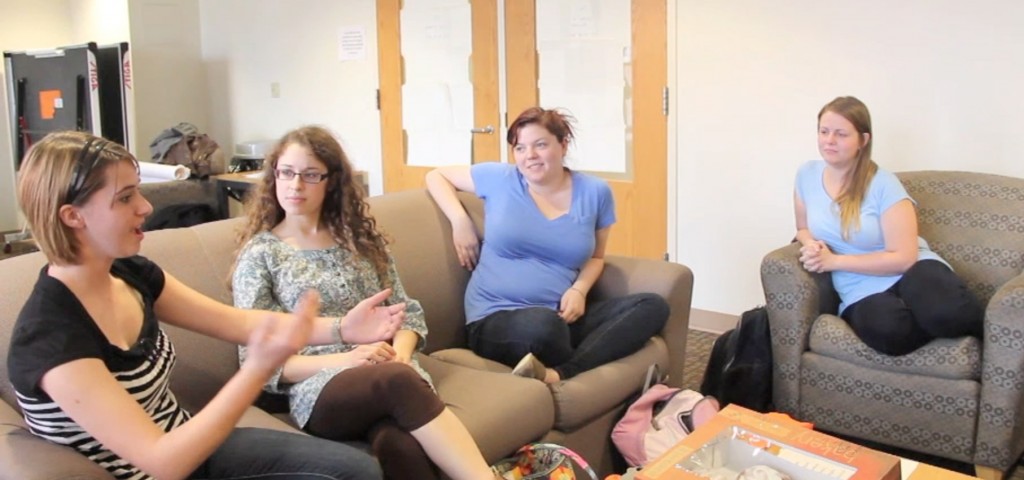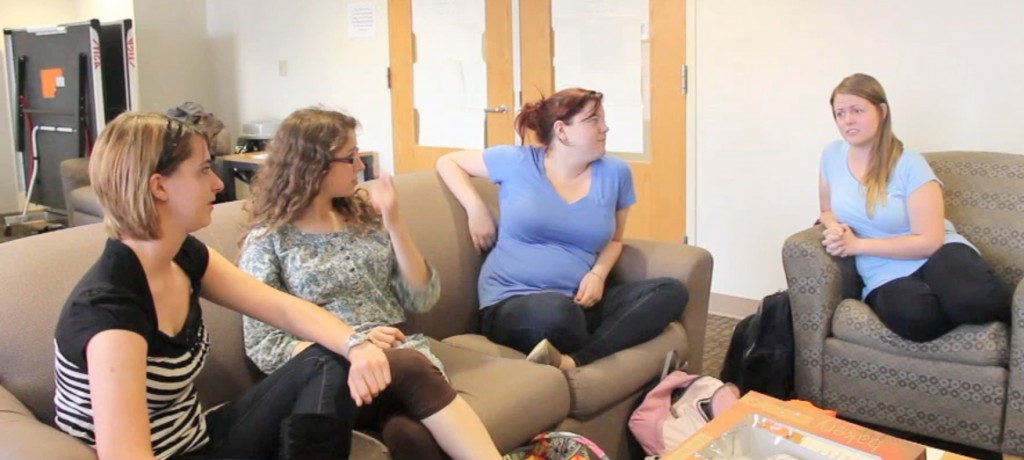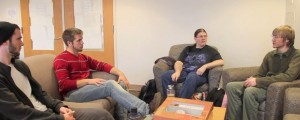Exercises for Turn-Taking
 Photo Exercise: Identifying the Speaker
Photo Exercise: Identifying the SpeakerFor each of the still photos (captured from a few videotaped conversations among college students), identify which person has the floor. (Depending on the timing of the photo-capture, the “speaker” may or may not have an open mouth, but you should still be able to identify who is holding the floor by following everyone’s gaze cues.
#1
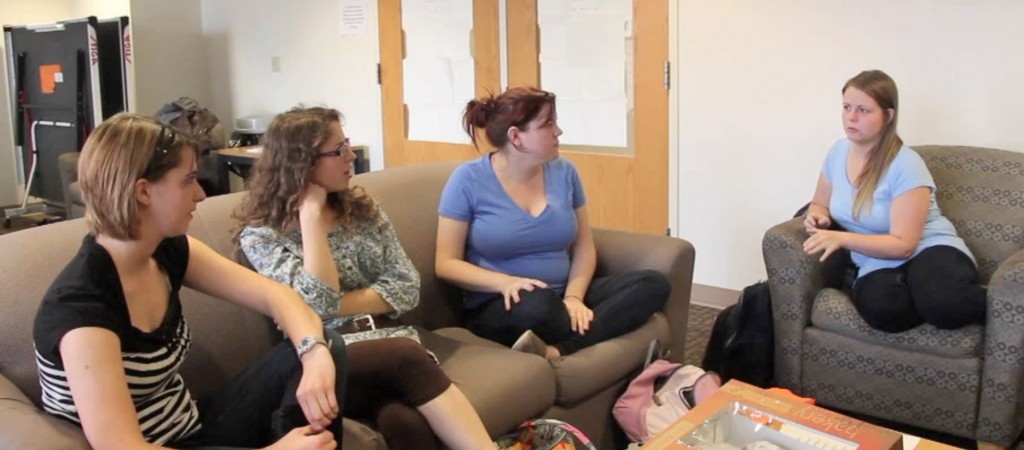
Answer
#2
Answer
#3
Answer
#4
#5
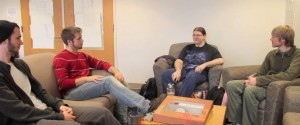
Answer
#6
#7
#8
 Video Exercise: Turn-Endings
Video Exercise: Turn-EndingsHere is a conversation in which the speakers are peers (equal in power), and almost all of the turn-taking happens via self-selection. How do they know when it is okay to speak? You will probably need to pause the video each time the speaker changes, and re-watch the transitions. Real-time conversation goes fast!
There’s a lot going on in just a minute of conversation! If you missed these clues, you may want to watch the video again (and again and again!) to look specifically for them.
Answers
- Change 1: The first speaker addresses her question to both of her companions (“you guys”). Obviously, the end of her question is the end of her turn, and a chance for either one to answer, which the young man does.
- Change 2: The young man trails off on “I don’t know” and then repeats “I don’t know what I’m going to do.” The trailing off is a typical ending sign, and the repetition makes it clear that he has nothing else to say at this point. The original speaker then self-selects.
- Change 3: The woman trails off while she’s lowering her pitch on “It’s not that much of an issue.” We hear the young man’s intake of breath while she is still speaking, and he begins to gesture simultaneously, indicating that he wishes to self-select, which he then accomplishes without any pause.
- (Non-Change): The young man has asked a rhetorical question (“But why bother? It’s never going to be an issue in my life.”) The original speaker makes a quick, overlapping interjection (“It might be.”) while the young man continues (“I mean, I’m never going to use…”). She may have misinterpreted his rhetorical question as the end of a turn, or she may just really want to argue with him. In any case, correctly recognizing that he wants to continue his turn, she stops after her short interjection and lets him finish.
- Change 4: As soon as he signals that he’s done (we hear a clear drop in his pitch as he says “in my life,” and he lets his gesturing hand drop down), the other young woman jumps in for the first time, self-selecting. The original speaker (in blue) makes it clear that she also has things to say (she tilts her head and purses her lips together), but recognizing that the other woman has gained the floor, she lets her speak.
- (Non-Change): The young woman offers a chance to the others to jump back in when she drops her pitch on “learning to think that way” and then pauses briefly. Since neither of the others self-selects at this point, she continues on.
- Change 5: The young woman appears to be finished when she drops her voice on “think logically,” and the man signals he wants to self-select with “Okay,” but the woman actually had another thought, so he waits for her to finish, then immediately jumps back in (“Okay, but…”). The rapidity of this turn-change and the false start are a sign of excitement; he is getting upset, as we can also detect from his voice growing louder, his gestures becoming wider and more emphatic, and his face getting red.
- Change 6: He signals the end of a turn by dropping his voice on “in my life.” The original speaker then self-selects. (She may have been particularly quick to do this, before he could resume, since he appears ready to engage in angry ranting.)
 Video Exercise: Turn-Openers
Video Exercise: Turn-OpenersWatch the video again, but this time, listen for turn-openers. Which ones do they use, and why?
Answers & Discussion
- The initial speaker does not use a turn-opener, since there are no previous turns to acknowledge, agree or disagree with. She just goes ahead and asks her question.
- The young man starts with “uhh….”, showing that he’s thinking about the question and is going to answer it.
- The original speaker resumes with “Mmm, well, I think…” The “mmm” acknowledges what he said, and the “well, I think” indicates that she’s going to disagree.
- He begins with “But, like,” indicating that he’s going to disagree with her.
- The utterances “It might be” (from the original speaker) and “It’s not about…” (from the woman in the dress) are bald disagreements, but the pronoun “it” in both utterances actually refers back to what the young man said, and thus serves as an acknowledgment of his utterance.
- He starts up again with “okay… okay but.” The “okays” here are clearly intended only as acknowledgment tokens, not as agreement markers, and the “but” clearly signals disagreement.
- The original speaker resumes with “well,” indicating upcoming disagreement.
 Practice Exercise: Group Turn-Taking Game
Practice Exercise: Group Turn-Taking GameIf you have a lot of trouble knowing when to take a turn in conversation, either because you can’t get a word in edgewise or because you’re accused of monopolizing the conversation, try getting a group of people together to play this game. It teaches you to monitor other people for signs that they want to speak, or want you to speak, without having to concentrate on actual meanings of words and sentences. Plus, it’s really fun! We’ve heard that some acting classes and casts use versions of this as a team-building exercise, to improve cooperation – you all have to win or lose together!
Instructions (adapted from Amelia Davis’ (2004) Teaching Asperger’s Students Social Skills Through Acting)
The goal is to count cooperatively to a specified number, with only one person speaking at a time, and each turn-at-talk consisting of just one number. Start low (say, 8; it has to be at least the number of people in your group) and increase the number gradually as your group improves.
The trick is that each person has to contribute – if you get to the goal number, but not everyone has taken a turn, you lose the game and have to start over. Furthermore, the order of contributions has to be unpredictable: you can’t just go clockwise around the circle, e.g., and there can be no simultaneous speech. If two people say a number at the same time, you have to start over. This requires each person in the circle to gaze around at all the other potential speakers, to see if they intend to speak or not, and if it’s safe to “jump in.”
As you get better at the game, introduce an additional constraint: If there are pauses longer than three seconds, you have to start over. (You can decrease the timing of the pauses as your group improves. See how low you can go!)
Once you’ve gotten good at the game, you should try your newly gained monitoring skills in a conversation. You’ll notice that even with the added complications of having to process and understand the words, and speakers having turns of indeterminate, unpredictable length, it may still feel easier than the game, because if two people do self-select, you don’t have to start again! You’ll also find that instead of just paying attention to the speaker’s words to understand them, you’ll also be listening for clues about whether or not they’re coming to an end of turn.
 Practice Exercise: Working Alone
Practice Exercise: Working AloneEven if you don’t have anybody to work with, you can still try to work on your turn-taking gaze and eye contact, assuming you don’t mind catching your own eye in the mirror. (If doing this does cause you discomfort, you can gradually desensitize yourself to it by doing it quite deliberately but briefly several times a day until the brief contact feels comfortable, then extending the period of time and practicing the longer time until it, too, feels comfortable.)
Instructions
- Sit or stand in front of the mirror and imagine that the person in the mirror is someone else.
- Recite a memorized nursery rhyme.
- Look away from your listener (the reflection in the mirror) while you speak, gazing at yourself only fleetingly and occasionally, without ever holding eye contact. Remember that in the U.S., speakers do not concentrate their gaze on the person they’re talking to (although they do expect listeners to gaze at them — which your listener will not be doing — so that they can catch their listeners’ eye whenever they want).
- When you come to a few words before the end of the turn, catch and hold the “listener’s” eye, to signal that it’s now their turn. It’s fine (for now) to have your glances be predictable, following the rhythm of the nursery rhyme. (This will help you remember to do it.)
- When you’ve finished the rhyme, give yourselves a mutual nod and a little smile: this is you (the current speaker) confirming that you’ve selected the reflected you as the next speaker, and it’s also the reflected you accepting the selection.
e.g. Mary had a little lamb (glance)
whose fleece was white as snow (glance)
and everywhere that Mary went (glance)
the lamb (catch and hold eye until the end) was sure to go. (nod & smile)
Once this feels comfortable, try just talking about a topic of interest to you — something you know about and can talk about, but for which you don’t have a memorized script with an obvious rhythm — and continue to use the same technique for gaze and eye contact. You can use the glances to call the listener’s attention to particularly important bits. Make sure you keep the turns short, both to practice what you learned in how much to say, and to get lots of practice in turn-taking!
 Observation Exercise
Observation ExerciseIf you are in a position to be a participant observer in a group of three or more people (a family dinner, a group of classmates working together on a project, some kind of group meeting for work, etc.) observe the system of turn-taking in action. Does it work smoothly, with each person able to contribute to the conversation? Could you spot the gaze cues that helped to select the next speaker? Were there cases in which the selected speaker refused the floor? Did one person have to make frequent, multiple starts before others would give them the floor? Did you hear instances of simultaneous speech? If so, how were they resolved? Were there extended pauses, where no one self-selected?
If you are not in a position to participate in such a group conversation, we do not recommend that you “eavesdrop” in a coffeeshop, as it would be difficult to fully observe a group’s turn-taking mechanisms without making it obvious that you were watching them closely, which will make them feel uncomfortable. Rather, you can observe turn-taking on TV shows. Group talk shows (such as The View, The Talk, pre- and post-game shows associated with major sporting events) feature rapid, unscripted, multi-person conversations. You will find multiple examples of the turn-taking mechanisms that we have described here, but also multiple examples of turn-taking problems and errors and how these get “repaired.” TV sitcoms and dramas feature scripted conversations, so you are less likely to encounter turn-taking errors and repair mechanisms, but can still offer good opportunities to observe turn-openings and turn-endings. Quite a few classic sitcoms had large ensemble casts, where groups of friends would sit around talking, e.g. Friends, How I Met Your Mother, Cheers, etc. Be aware, though, that the patterns of gaze on the scripted shows is generally not realistic, and the camera-work (zooming in and out of closeups, switching angles) makes it almost impossible to follow the speakers’ gaze, anyway.
